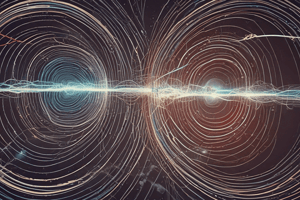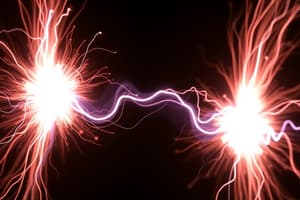Podcast
Questions and Answers
What is the right-hand rule used for in the context of a straight current-carrying conductor?
What is the right-hand rule used for in the context of a straight current-carrying conductor?
- To determine the direction of the magnetic field around the conductor (correct)
- To calculate the strength of the magnetic field around the conductor
- To determine the resistance of the conductor
- To measure the electric current in the conductor
What is the primary function of an electromagnet?
What is the primary function of an electromagnet?
- Creating a strong magnetic field by passing an electric current through a coiled wire (correct)
- Converting mechanical energy into electrical energy
- Producing a strong magnetic field without using electric current
- Generating electric current in a coil
How do electric motors operate based on the interaction between magnetic fields?
How do electric motors operate based on the interaction between magnetic fields?
- By generating a fixed magnetic field using electric current
- By converting magnetic energy into electrical energy
- By utilizing the interaction between the magnetic field produced by current-carrying conductors and fixed magnetic fields from permanent magnets (correct)
- By using the right-hand rule to determine the direction of the magnetic field
What is the main principle behind the functionality of transformers?
What is the main principle behind the functionality of transformers?
What happens to the magnetic field intensity as the distance from a current-carrying conductor increases?
What happens to the magnetic field intensity as the distance from a current-carrying conductor increases?
In constructing an electromagnet, what material is typically coiled with a wire to create a strong magnetic field?
In constructing an electromagnet, what material is typically coiled with a wire to create a strong magnetic field?
What is the role of the right-hand rule in determining the direction of magnetic fields in a coiled wire or solenoid?
What is the role of the right-hand rule in determining the direction of magnetic fields in a coiled wire or solenoid?
What is the outcome of the interaction between magnetic fields in electric motors?
What is the outcome of the interaction between magnetic fields in electric motors?
What is one of the primary applications of electromagnets?
What is one of the primary applications of electromagnets?
How does the changing magnetic field produced by alternating current in one coil impact another coil in transformers?
How does the changing magnetic field produced by alternating current in one coil impact another coil in transformers?
Who first discovered the magnetic field created by an electric current?
Who first discovered the magnetic field created by an electric current?
What shape do the magnetic field lines around a current-carrying wire form?
What shape do the magnetic field lines around a current-carrying wire form?
How can the direction of the magnetic field lines be determined?
How can the direction of the magnetic field lines be determined?
What determines the strength of the magnetic field produced by an electric current?
What determines the strength of the magnetic field produced by an electric current?
How does reducing the current affect the magnetic field produced by an electric current?
How does reducing the current affect the magnetic field produced by an electric current?
What fundamental concept does the magnetic field of an electric current lay the foundation for understanding?
What fundamental concept does the magnetic field of an electric current lay the foundation for understanding?
Flashcards are hidden until you start studying
Study Notes
The magnetic field of an electric current is a fascinating and fundamental concept in physics. When an electric current flows through a conductor, it creates a magnetic field around it. This phenomenon was first discovered by Hans Christian Oersted in 1820, and it laid the foundation for the understanding of electromagnetism. In this article, we will delve into the magnetic field of electric current, exploring its properties, the right-hand rule, and its applications in everyday life and technology.
Understanding the Magnetic Field of Electric Current
When an electric current flows through a conductor, it generates a magnetic field around the conductor. The magnetic field produced by a current-carrying wire consists of concentric circular lines of force that encircle the wire. The direction of the magnetic field lines can be determined using the right-hand grip rule, which states that if the right hand grasps the conductor with the thumb pointing in the direction of the current, the curled fingers will indicate the direction of the magnetic field lines.
The strength of the magnetic field produced by an electric current depends on the magnitude of the current. Greater current results in a stronger magnetic field, while reducing the current weakens the magnetic field. Additionally, the magnetic field intensity decreases as the distance from the current-carrying conductor increases.
The Right-Hand Rule
The right-hand rule is a fundamental tool used to determine the direction of the magnetic field produced by a current-carrying conductor. There are two variations of the right-hand rule, one for determining the direction of the magnetic field around a straight current-carrying conductor and the other for a coiled wire or solenoid.
For a straight conductor, when the right hand is used with the thumb pointing in the direction of the current, the fingers curl in the direction of the magnetic field lines. In the case of a coiled wire or solenoid, the right-hand rule can be applied to determine the direction of the magnetic field inside the coil and the direction outside the coil.
Applications of the Magnetic Field of Electric Current
The magnetic field of electric current has numerous practical applications across various fields. One of the most common applications is in the construction of electromagnets. By coiling a wire around a ferromagnetic material and passing an electric current through the wire, a strong magnetic field is created, resulting in the formation of an electromagnet. Electromagnets are used in a wide range of devices, including electric motors, loudspeakers, MRI machines, and magnetic levitation trains.
Another important application of the magnetic field of electric current is in the functioning of electric motors. Electric motors operate based on the interaction between the magnetic field produced by the current-carrying conductors and the fixed magnetic field generated by permanent magnets. This interaction leads to the rotation of the motor's shaft, converting electrical energy into mechanical energy.
In addition to electromagnets and electric motors, the magnetic field of electric current plays a crucial role in the functionality of transformers. Transformers utilize the principles of electromagnetic induction, where the changing magnetic field produced by the alternating current in one coil induces a voltage in another coil. This process allows for the efficient transmission of electrical energy across different voltage levels.
Conclusion
The magnetic field of electric current is a fundamental concept with a wide range of applications in everyday life and technology. From the simple right-hand rule to the intricate construction of electromagnets and the operation of electric motors, the understanding of this phenomenon has revolutionized the way we harness and utilize electrical energy. As we continue to advance in technology and innovation, the magnetic field of electric current will undoubtedly remain a cornerstone in the field of electromagnetism.
Studying That Suits You
Use AI to generate personalized quizzes and flashcards to suit your learning preferences.




